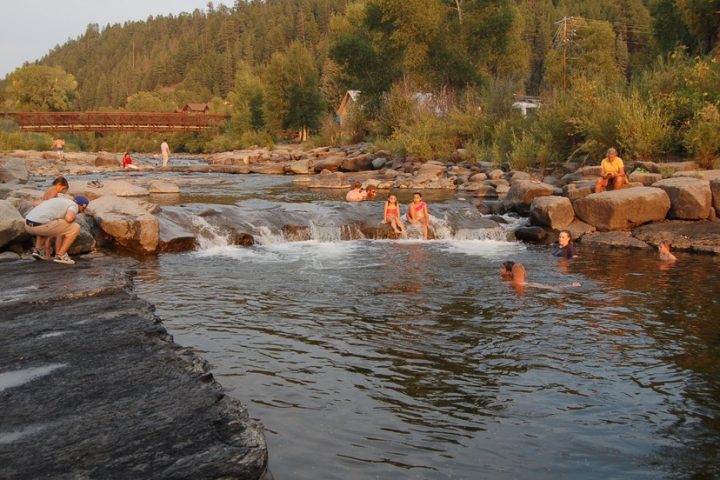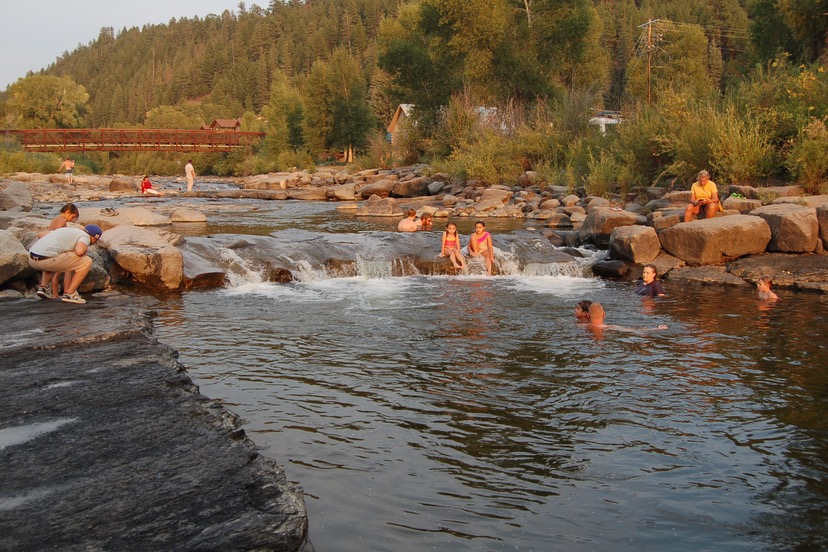As we listened to Town Planning Director James Dickhoff present the two plans for enhancing the aquatic life in the San Juan River, I found myself thinking about the two primary forms of aquatic life under discussion.
Fish. And tourists.
The fish live here pretty much full-time, as do most of us taxpayers. The tourists come and enjoy themselves, and then leave.
One of the projects Mr. Dickhoff was presenting to the Town Council on Thursday, September 23 would improve the habitat for both tourists and fish, in the San Juan River south of Yamaguchi Park — adjacent, in fact, to the southern extension of Yamaguchi Park which the Town Council hopes to create someday on the site of the now-abandoned sewer treatment plant. The entire park project has been estimated at $15 million. The aquatic enhancements Mr. Dickhoff was urging the Council to help fund would cost an estimated $660,000, and would consist of whitewater structures and enhanced fish habitat.
The Town began adding fishing enhancements to the river in the late 1990s, and ‘whitewater’ features beginning in 2005.
Whether the fish are happier, we cannot say. The tourists seem to enjoy the river enhancements.

This South Yamaguchi project has been through months of discussion, including public surveys and informational meetings, and the Town Council didn’t have any hesitation approving money from its 2021 budget to help fund the enhancement project.
The second project presented by Mr. Dickhoff on September 23 would add dozens of “improvements” to a three-mile stretch of the San Juan, north of downtown, starting at the site of the old Weber Sand & Gravel gravel pit and ending near the Conoco gas station at the east end of town.
Both projects might qualify for grant funding from the Colorado Water Conservation Board (CWCB), a state-funded agency that, once upon a time, had a mission to “conserve” Colorado water, but, more recently, has become increasingly interested in tourism and fish habitat.
Interested, that is to say, in aquatic life.
Besides acting at the Town’s Planning Director, Mr. Dickhoff also serves on the steering committee of the Upper San Juan Watershed Enhancement Partnership (WEP), an division of Durango-based Mountain Studies Institute. Another member of the WEP steering committee participated in the Thursday presentation: local activist Mely Whiting, Colorado Water Project Legal Counsel with Trout Unlimited. Ms. Whiting reminded the Council that CWCB has been blessed, at this moment in time, with a surprising quantity of taxpayer funding, that’s currently available — if you have the right project — for grant funding.
The WEP is proposing to get their hands on some of that money, to enhance our river, and to help fund the operations of Mountain Studies Institute.
As mentioned in Part Two, I had a chance to hear a similar presentation during a budget discussion on Monday, September 20, when the San Juan Water Conservancy District (SJWCD) discussed a draft budget. The draft budget had included, at the WEP’s request, a possible $2,500 line item to help fund the WEP’s “three-mile upstream project”.
Government budgets in Colorado have some strict limitations. (At least, I think they are intended to be strict?) A government entity must publicly post a draft budget by October 15 each year, and must hold a public hearing before approving that budget.
Once a budget is created, the entity must follow their budget, and cannot make changes willy-nilly. (The Town of Pagosa Springs, being ‘home rule’, has claimed the authority to essentially ignore this part of Colorado law.)
Also, a government entity cannot encumber — promise, spend, or create contractual obligations for — money expected to be collected in a future year, without taxpayer approval. Generally speaking.
So when SJWCD received the WEP request for $2,500, that amount was placed into a draft 2022 budget, but no promises were made. Legally, no promise could be made. We had not yet held the required public hearing.
(Note: I serve on the the SJWCD board, but this editorial does not necessarily reflect the opinions of the SJWCD board as a whole.)
At the September 20 SJWCD meeting, I argued that our district board should not help fund the WEP upstream project until the WEP fixed a problem they had created.
Specifically, the WEP appears to have broken a promise.
Thus far, the WEP has spent about $270,000 on Phase I and Phase II of a “Stream Management Plan”. This plan is supposed to reflect the wishes of the people of Archuleta County, with all their varied water requirements.
Here is a quote from the WEP’s Phase I grant application (with my emphasis added):
C. Proposal Effectiveness:
The success and relevance of stream management planning efforts are highly dependent on stakeholder engagement. Because a stakeholder group to coordinate efforts in the Upper San Juan Basin does not currently exist, this proposal is a critical first step toward the success of any SMP [Stream Management Plan] efforts…
During the Phase I of the Upper San Juan River Basin stream management plan, MSI will convene a steering committee to help frame the stakeholder process, recruit participants from a wide range of water and community interests, and guide the SMP process. With the assistance of the steering committee, MSI will convene community stakeholders to assess consumptive and non-consumptive values, including E&R needs within the basin, and to identify gaps with the ultimate goal of outlining an assessment that can prioritize projects and processes to meet those needs.
While specific needs, gaps and opportunities will not be evaluated until Phase II of the project, this initial phase is critical; without the establishment of a committed and representative local stakeholder group, future efforts are not likely to be sustainable. As such, this initial work scope is committed to building and supporting said group.
Various local and regional governments, including CWCB and SJWCD, contributed taxpayer funding to Phase I, to support a WEP budget of $68,000. The promise from WEP, as we see above, was to form a “stakeholder group” representing a wide range of community interests. The water from the San Juan River serves many local needs, and those needs are sometimes in competition with one another. We have seen, recently, successful stakeholder groups formed in other Colorado communities, to work through these conflicts and develop compromise solutions for meeting everyone’s water needs.
The Phase I grant application indicates that the WEP intended to form that type of community-wide stakeholder group here in Archuleta County, to “guide the SMP process.”
But apparently, the WEP never formed a stakeholder group. They only formed a steering committee… and the steering committee’s job was to form a stakeholder group.
Despite the fact that “this initial work scope [Phase I] is committed to building and supporting said group…” the WEP never formed said group.
But the group still managed to spend the $68,000 allocated for Phase I. And then, on to Phase II. And Phase III…

